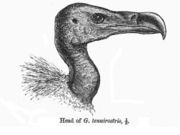Long-billed Vulture
Conservation status: Critical |
| |
|
Scientific classification |
| Kingdom: |
Animalia
|
| Phylum: |
Chordata
|
| Class: |
Aves
|
| Order: |
Falconiformes
|
| Family: |
Accipitridae
|
| Genus: |
Gyps
|
| Species: |
G. indicus
|
|
|
Binomial name |
Gyps indicus
(Scopoli,
1786) |
The Long-billed Vulture, Gyps indicus, is
an
Old World vulture in the family
Accipitridae, which also includes
eagles,
kites,
buzzards and
hawks. It is closely related to the
European
Griffon Vulture, G. fulvus. Some sources treat
the birds in the eastern part of its range as a separate
species, the Slender-billed Vulture Gyps
tenuirostris.
It breeds on crags or in trees in mountains in India and
South-east Asia, laying one egg. Birds may form loose
colonies. The population is mostly resident.
Like other
vultures it is a scavenger, feeding mostly from
carcasses of dead
animals which it finds by soaring over savannah and
around human habitation. It often moves in flocks.
The Long-billed Vulture is a typical vulture, with a bald
head, very broad wings and short tail. It is smaller and
less heavily-built than European Griffon. It is
distinguished from that species by its less buff body and
wing coverts It also lacks the whitish median covert bar shown by Griffon.
This and the Indian White-rumped Vulture, G. bengalensis
species have suffered a 99% - 97% decrease in India and the
cause of this has been identified as poisoning caused by a
veterinary drug Diclofenac. Diclofenac is a non-steroidal
antiinflamatory drug (NSAID) and it is given to working
animals to help prevent joint pain and so keep them working.
The drug is believed to be swallowed by vultures with the
flesh of dead cattle which have been given diclofenac in the
last days of life. Diclofenac causes kidney failure in the
birds.
[1]. In March 2005 the Indian Government announced its
support for a ban on the veterinary use of diclofenac.
Meloxicam (another NSAID) has been found to be harmless
to vultures and should prove to be an acceptable substitute.
In March 2006 diclofenac was still being used for animals
throughout India and the changes in Indian legislation are
awaited. When meloxicam production is increased it is hoped
that it will be as cheap as diclofenac.
Captive breeding programmes
Captive breeding programmes for several species of Indian
vultue have been started. The vultures are long lived and
slow in breeding, so the programmes are expected to take
decades. Vultures reach breeding age at about 5 years old.
It is hoped that captive breed birds will be released back
to the wild when the invironment is clear of diclofenac.

Head of Slender-billed Vulture
References
- BirdLife International (2004).
Gyps indicus. 2006
IUCN Red List of Threatened Species. IUCN 2006. Retrieved on 09 May 2006. Database entry
includes a range map and justification for why this
species is critically endangered
External link




